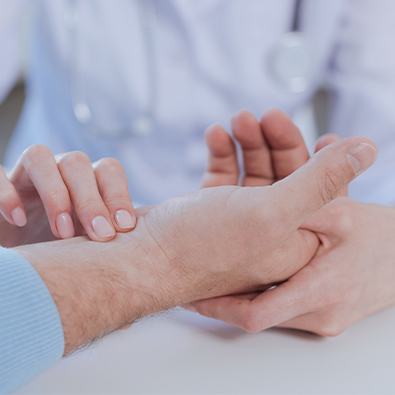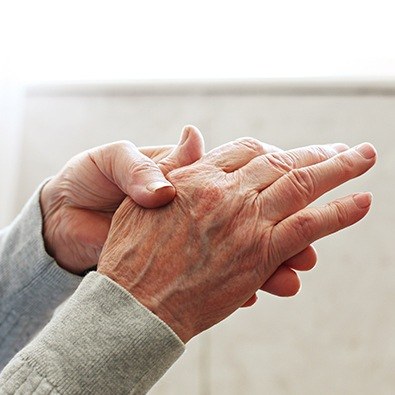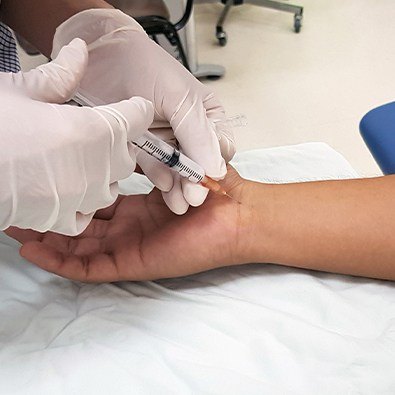
Fax: (860) 430-9693
Glastonbury, CT 06033

One of the most common regions of the body affected by osteoarthritis is the thumb and fingers. The joints at the base of the thumb--the CMC (carpometacarpal) and MCP (metacarpophalangeal)--joints are the most commonly affected joints in the hand, followed by the smaller joints of the fingers (the IP, or interphalangeal joints). The joints of the wrist can also be affected, but much less commonly than the fingers. Keep in mind that we're talking about osteoarthritis (the "wear and tear" kind), not Rhuematoid Arthritis, which is a destructive inflammatory medical condition that affects the joints. Pain in these joints nonetheless can be debilitating, affecting both work and recreational activities. We offer solutions for treating arthritis of the hands, wrists, and fingers in Glastonbury, CT at Valley Sports Physicians & Orthopedic Medicine.

Symptoms of Wrist & Hand Arthritis include stiffness and pain that classically is worst after long periods of inactivity (such as first thing in the morning) and pain after prolonged or strenuous use. Light activity tends to help, while more strenuous activities seem to aggravate it. Affected joints can become enlarged or swollen, and they can be tender to touch and move. Grip strength can weaken over time, not so much because the muscles weaken, but because pain in the joints inhibits muscle function. In spite of joint enlargement and swelling, osteoarthritis does NOT tend to cause severe deformities like Rheumatoid Arthritis.
Learn More About Symptoms of Wrist and Hand Arthritis

Diagnosing wrist & hand osteoarthritis is based on the physical exam and x-rays. Lab tests are not needed to make the diagnosis but may be helpful to identify other possible causes, such as Rheumatoid Arthritis. However, keep in mind that just because an x-ray shows arthritis it doesn't mean that the arthritis is the cause of the pain. We often see patients who have worse arthritis on x-ray in the joints that don't hurt! Often, to help confirm the diagnosis we'll simply inject the suspected joint(s) with a little anesthetic to numb the joint. If the pain goes away, we found the culprit. But if it doesn't go away, we need to keep looking!


In addition to providing diagnoses and treatment for our patients dealing with hand and wrist arthritis, our team is happy to answer any questions people might have as well. We’re always willing to take the time to put people at ease or go into more detail about their condition and care options. Below, we’ve gone ahead and answered some of our most common questions related to this subject, but you’re always welcome to give us a call if you have something else you’d like to ask.
Osteoarthritis in any joint can occur due to several factors, with the primary ones being injury, overuse, and genetics. At your initial appointment, we’ll ask about your symptoms and when they seem to flare up because the times you feel pain can be a big indicator, like if it is worse in the morning or after a certain activity. Various sports and construction/assembly line jobs can lead to OA in the hands and wrist due to repetitive motion over a long period of time, which wears down the joint cartilage.
Treatment for OA is an ongoing process in most cases, as nothing other than surgery can fully stop the degeneration of the joint cartilage. Typically, a patient comes to see us on a predetermined basis (whether it is once every few weeks or once every few months) so we can apply treatment and evaluate how it is working. Many treatments only take a few minutes, as they only involve a few injections, but something like physical therapy may require more time and frequency. Dr. Tortland will adjust his approach over time to suit the patient and deliver the best outcome.
Because OA in the hands and wrist often stems from someone’s job, it can be difficult to get away from the activities that cause the pain, swelling, and stiffness to worsen. Thankfully, a combination of bracing, medication, activity modification, physical therapy, and/or regenerative medicine has been shown to help people in a wide variety of careers feel and function better while keeping their work schedule. Our treatments are designed to be minimally invasive so patients can get the care they need without having to take a significant amount of time off.
The cost of OA treatment can vary greatly from person to person depending on the type of care they receive. For example, PRP therapy is relatively affordable, but it can take time for a patient to start noticing results. On the other hand, stem cell therapy typically works much faster, but it is more expensive. Balancing someone’s expectations, needs, and budget will help us determine the right treatment regimen so that it is ideally suited to a patient’s body and wallet.